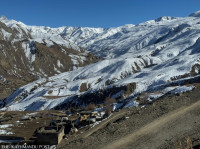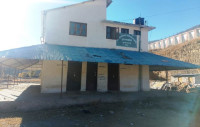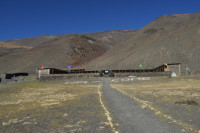Karnali Province
Karnali does not have a food shortage—it has a rice shortage, locals say
Decades of rice supplies by the government and the World Food Programme have led locals to adopt rice as a staple food, even though it was never an indigenous grain.
Tularam Pandey
Nama Raj Pyakurel’s paddy field did not yield a single grain this year when last year, the same field had produced five sacks of rice. Pyakurel doesn’t quite know why this happened but wonders if it’s the fault of the seeds he brought from Kailali.
“For us, this is a subject of perennial worry,” he said. “But this year hit a new low.”
Read: How rice became a staple in the hills and mountains—and why that’s unsustainable
Despite a lack of paddy production, Pyakurel harvested a decent amount of other crops—three sacks of maize, four of millet, five sacks of potatoes, a sack each of buckwheat and beans.
“But rice is important,” said Pyakurel, whose farm is in Palata, Kalikot. “Even if we produce other crops, we purchase rice after selling them.”
For many farmers like Pyakurel in Karnali, rice is the staple food—it’s what they eat every day, even though much of the province is inhospitable to paddy production. The government has thus been supplying rice to Karnali region for over five decades.
Karnali has long been deemed a food-insecure region, leading the government to dispatch hundreds of tonnes of rice every year. According to Nirmal Thapa, chief of the Food Management and Trading Company, this year Kalikot district alone will receive 5,900 quintals of rice, of which 1,170 has already reached Manma, the district headquarters.
According to the Agriculture Development Office, Kalikot requires 32,119 metric tons of food every year on average. But the district only produces 17,432 tonnes. As per data from the provincial ministry of agriculture, there was a food shortage of 18,407 tonnes in the fiscal year 2017-18. There was a shortage of 14633 tonnes foodstuffs in Kalikot alone. This year, the district produced 7,851 tonnes of paddy, 6,464 tonnes of wheat, 6,412 tonnes maize, and 2,095 tonnes millet.
A survey conducted by the National Planning Commission and the World Food Programme earlier this year showed that 35 percent households in Karnali Province are food-insecure while seven percent households remain without food for at least a day due to financial problems, according to the survey. Due to this lack of food, around 45 percent children in Karnali suffer from malnutrition.
But Karnali is not food insecure, say locals.
“When people say the districts in Karnali are reeling under a food shortage, what they actually mean is that there is a shortage of rice,” said Khadak Bahadur Malla, a farmer from Khatyad.
Karnali was once independent when it came to rations, according to Tularaj Bista, a former lawmaker from the region. Animal husbandry was the default profession and people made clothes out of sheep wool.
“Before the government started distributing rice, Karnali produced enough maize, millet, buckwheat and other crops to feed itself,” said Bista. “Rice was not a necessity as it is today.”
For many, this over-reliance on rice is alarming. Junga Bahadur Karki, ward chair of Khatyad Rural Municipality in Mugu district, said that farmers are getting “increasingly lazy”, now that the area is connected with a road network via the Surkhet-Jumla section of Karnali Highway.
“It’s not as hard to buy rice as it was a decade ago,” said Karki.
The opening of the road section has meant that it is easier for many organisations besides the government to distribute rice in the region, increasing their dependence on an imported grain.
“This has led to a decline in the production of other food crops such as maize, millet and buckwheat,” said Mahendra Bahadur Shahi, chief minister of Karnali Province.
According to locals, the government’s rice supply is helping with the food insecurity in the short term but is increasing the region’s long-term dependence on imports. No concrete effort has been made to make Karnali independent, said Bista.
“Today, even if there are irrigation facilities, fields are left barren,” he said. “The government is inclined towards distributing rice but what it should have actually done is devise a long-term solution.”
Places such as Raskot in Kalikot and Sinja in Jumla have long been known as ‘pocket areas’ for paddy production, producing hardy variants of rice that were richer in fibre than imported white rice. But once locals started receiving subsidised rice from the World Food Programme’s project, rice farming declined, says Nanda Bahadur Shahi, a leader from the Nepal Workers and Peasants Party.
“Today, almost every household eats rice for dinner and lunch,” said Shahi. “People have stopped cultivating crops such as buckwheat, chino and kaguno.”
According to Bharat Basnet, chief of the Agriculture Development Office, it is possible to make Karnali independent when it comes to food but it will be difficult, given the province’s reliance on rice.
“There is a lot to be done but for the time being, what the region immediately needs is an agriculture school and modernisation of farming, if it is to be independent again,” Basnet said.




 18.12°C Kathmandu
18.12°C Kathmandu










